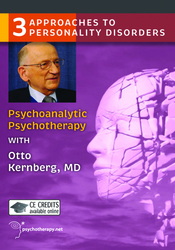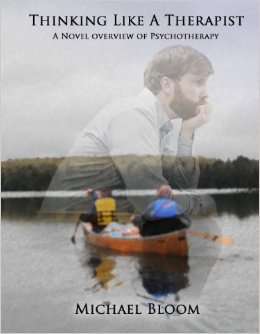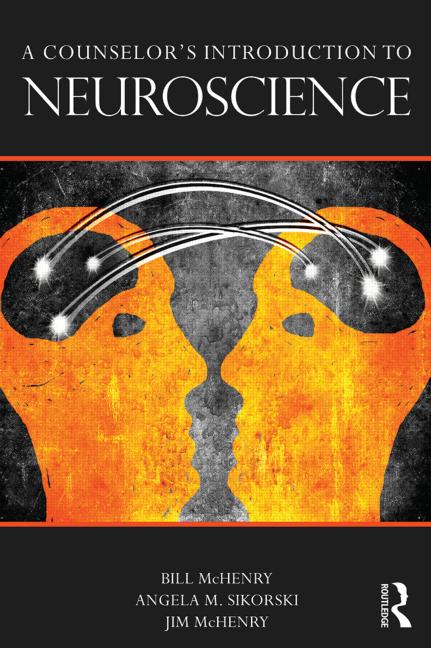Jun 5, 2014 | Video Reviews
 In this 4-hour and 16-minute video, psychotherapist Otto Kernberg demonstrates Transference-Focused Psychotherapy (TFP) in three live sessions with a 40-year-old patient named Alfred (portrayed by an actor). TFP is an evidence-based treatment that is effective for individuals struggling with personality disorders. It is specifically helpful for individuals with borderline and narcissistic personality disorders, and focuses on treating the individual’s entire personality.
In this 4-hour and 16-minute video, psychotherapist Otto Kernberg demonstrates Transference-Focused Psychotherapy (TFP) in three live sessions with a 40-year-old patient named Alfred (portrayed by an actor). TFP is an evidence-based treatment that is effective for individuals struggling with personality disorders. It is specifically helpful for individuals with borderline and narcissistic personality disorders, and focuses on treating the individual’s entire personality.
Kernberg engages in TFP with Alfred, who suffers from a personality disorder. Using a psychodynamic TFP approach, Kernberg demonstrates how therapists can conduct treatment. From the TFP perspective, personality disorders develop due to dysfunction in early life as well as genetic factors. They can specifically occur due to insecure attachment to a caregiver, severe trauma and/or severe family pathology that is transmitted in the interaction between family members. TFP focuses on helping patients change their distorted perceptions of others, internalized messages, and self-image. Dr. Kernberg builds a relationship with Alfred to demonstrate how this can be accomplished in a therapeutic setting, by using transference analysis, interpretation, and technical neutrality.
For example, during the first session, Alfred becomes suspicious of Dr. Kernberg because he perceives him as taking the side of his previous therapist. Dr. Kernberg confronts the patient about his contradictory attitudes and reinforces the realistic side of Alfred’s statement. He also interprets Alfred’s desire to leave therapy as a fear of attack and betrayal by everyone, including the therapist.
In subsequent sessions, Kernberg responds to Alfred’s distorted views of his relationships, particularly with his ex-girlfriend. Kernberg intermittently interjects his commentary for the viewer throughout the sessions. He helps explain common symptoms of personality disorders and applies them directly to what transpires within each session. He also explains each session’s progress as well as the reasoning for his questions, which helps the viewer understand the theory and how to use it.
The video is supplemented with an instructor’s manual which offers valuable tips for making the best use of the video. The instructor’s manual contains a transcript of the sessions, which helps highlight key moments in the video. It also contains discussion questions that can be used to facilitate dialogue. For example, in session two, one of the discussion questions addresses the patient’s feelings of betrayal as follows: “What do you think of Kernberg’s straightforward way of interpreting Alfred’s avoidance of feelings of betrayal? How do you imagine different clients responding to this style? How does it match or differ from your own?” The instructor’s manual also contains suggestions for activities related to the video, such as a reaction paper and role-play exercise. The instructor’s manual is useful, but a little difficult to navigate.
This video seems appropriate for a relatively higher-level mental health professional or student. It offers a unique perspective on the therapeutic techniques of TFP. Unlike reading a textbook, watching this video gives the viewer a comprehensive understanding of the theory, effectively bringing it theory to life. The video could be a useful teaching tool for instructors and learning tool for students.
Reviewed by: Nicole Berry, Barry University.
Yalom, V. (2007). Psychoanalytic Psychotherapy with Otto Kernberg, MD [DVD]. Mill Valley, CA: Psychotherapy.net.
Available at http://www.psychotherapy.net
Jun 5, 2014 | Book Reviews
 Set against a backdrop of survival, Michael Bloom’s Thinking Like a Therapist provides readers with a different approach to the typical case study. The author follows a young couple through an immense tragedy and subsequent strife, inviting the reader on a journey through isolation and its effects on the couple’s relationship. In a unique conceptualization of a case study, the author juxtaposes scenes of the couple fighting for their lives with scenes of the couple in therapy sessions, as though they can magic themselves from the wilderness to the therapist’s office. Each chapter has three sections: journal entries narrating part of the couple’s adventures, a dialogue between the couple and the therapist, and a discussion of the therapist’s goals and interventions in the preceding therapy session. The book offers a new approach to discussing mental health therapy in a more entertaining fashion than typical counseling books.
Set against a backdrop of survival, Michael Bloom’s Thinking Like a Therapist provides readers with a different approach to the typical case study. The author follows a young couple through an immense tragedy and subsequent strife, inviting the reader on a journey through isolation and its effects on the couple’s relationship. In a unique conceptualization of a case study, the author juxtaposes scenes of the couple fighting for their lives with scenes of the couple in therapy sessions, as though they can magic themselves from the wilderness to the therapist’s office. Each chapter has three sections: journal entries narrating part of the couple’s adventures, a dialogue between the couple and the therapist, and a discussion of the therapist’s goals and interventions in the preceding therapy session. The book offers a new approach to discussing mental health therapy in a more entertaining fashion than typical counseling books.
What Bloom does exceptionally well is illuminate the inner workings of a therapist’s mind. He offers readers well-articulated insights into the mind of a highly competent therapist, which is an excellent learning tool for those studying the art of counseling. The therapist acts with intentionality, and Bloom clearly demonstrates the process of translating thought into action. Novice counselors will learn the importance of intentionality as well as the importance of implementing structure into counseling.
Readers unfamiliar with the counseling field will be introduced to what counseling looks like and how the process of change manifests itself outside sessions. Even though the events surrounding the young couple are extreme in nature, what surfaces during their excursion is highly relatable to anyone who has been in an intimate relationship. Among the many issues the couple work through are joint decision making, depression, differentiation, boundaries, jealousy, and sexual intimacy. Bloom describes the couple’s struggles and successes with the eye of a behavioral expert. Ultimately, all readers will find the implications of Bloom’s book realistic and applicable.
Reviewed by: Joseph M. Graham, Jr., doctoral student in counselor education, University of Central Florida, Orlando, FL.
Bloom, M. (2013). Thinking like a therapist: A novel overview of psychotherapy. Sioux Falls, SD: Cogitavi.
Jun 5, 2014 | Book Reviews
 In A Counselor’s Introduction to Neuroscience, the authors claim that “neurocounseling” is the fifth force in the history of psychology and counseling. Although a precise and detailed definition of neurocounseling is elusive (both in this book and in the professional literature), it is described as the marriage of counseling and neurobiology. They offer a crash course in brain anatomy, function and development in order to lay the groundwork for how neurocounseling can be used effectively with clients. Several chapters focus on the ways the brain is affected by certain mental disorders, and how specific counseling approaches address various brain regions and functions. The remainder of the book focuses on assessment of brain function and fictional cases to illustrate neurocounseling techniques. The chapters include numerous tables, figures, cases and opportunities to stop and reflect. The overall intent of the book is to arm counselors “with yet another highly effective and efficient way to help clients cope with (overcome, etc.) their personal psychological distress.”
In A Counselor’s Introduction to Neuroscience, the authors claim that “neurocounseling” is the fifth force in the history of psychology and counseling. Although a precise and detailed definition of neurocounseling is elusive (both in this book and in the professional literature), it is described as the marriage of counseling and neurobiology. They offer a crash course in brain anatomy, function and development in order to lay the groundwork for how neurocounseling can be used effectively with clients. Several chapters focus on the ways the brain is affected by certain mental disorders, and how specific counseling approaches address various brain regions and functions. The remainder of the book focuses on assessment of brain function and fictional cases to illustrate neurocounseling techniques. The chapters include numerous tables, figures, cases and opportunities to stop and reflect. The overall intent of the book is to arm counselors “with yet another highly effective and efficient way to help clients cope with (overcome, etc.) their personal psychological distress.”
Although the authors are clearly enamored with the interaction between neurobiology and counseling, they purposefully offer honest words of caution regarding the nascent and speculative nature of contemporary brain science. However, on occasion, they also make promising statements without citing scientific evidence and generalize results from animal studies (including rodents) to humans without offering their reasoning for doing so. As with any other resource, practitioners are responsible for weighing information and evaluating whether it is accurate and whether it will be helpful in their work. It is important to note that this book bills itself as an “introduction”—readers should not expect concrete or realistic examples of how professional counselors can use their new neuroscience knowledge to understand and enhance client functioning.
A Counselor’s Introduction to Neuroscience will help counselors begin to grapple with the implications of neuroscience for our profession. Although the neuroscience knowledge base that the authors provide is a good start, scientific rigor in terms of concrete application would be useful. Years from now, neurocounseling may well be a new force in counseling, but presenting it to the counseling community as an effective and efficient way to help clients today is premature. In the end, it is best to consider this book as a reasonable beginning and food for thought rather than a how-to guide for counselors seeking neurocounseling training. Hopefully in the ensuing years, there will be clearer guidance available to help professional counselors integrate neuroscience into their practice.
Reviewed by: Tara Smart and John Sommers-Flanagan, University of Montana.
McHenry, B., Sikorski, A. M., & McHenry, J. (2014). A counselor’s introduction to neuroscience. New York, NY: Routledge.
Available at http://www.routledge.com/books/details/9780415662284/
 In this 4-hour and 16-minute video, psychotherapist Otto Kernberg demonstrates Transference-Focused Psychotherapy (TFP) in three live sessions with a 40-year-old patient named Alfred (portrayed by an actor). TFP is an evidence-based treatment that is effective for individuals struggling with personality disorders. It is specifically helpful for individuals with borderline and narcissistic personality disorders, and focuses on treating the individual’s entire personality.
In this 4-hour and 16-minute video, psychotherapist Otto Kernberg demonstrates Transference-Focused Psychotherapy (TFP) in three live sessions with a 40-year-old patient named Alfred (portrayed by an actor). TFP is an evidence-based treatment that is effective for individuals struggling with personality disorders. It is specifically helpful for individuals with borderline and narcissistic personality disorders, and focuses on treating the individual’s entire personality. Set against a backdrop of survival, Michael Bloom’s Thinking Like a Therapist provides readers with a different approach to the typical case study. The author follows a young couple through an immense tragedy and subsequent strife, inviting the reader on a journey through isolation and its effects on the couple’s relationship. In a unique conceptualization of a case study, the author juxtaposes scenes of the couple fighting for their lives with scenes of the couple in therapy sessions, as though they can magic themselves from the wilderness to the therapist’s office. Each chapter has three sections: journal entries narrating part of the couple’s adventures, a dialogue between the couple and the therapist, and a discussion of the therapist’s goals and interventions in the preceding therapy session. The book offers a new approach to discussing mental health therapy in a more entertaining fashion than typical counseling books.
Set against a backdrop of survival, Michael Bloom’s Thinking Like a Therapist provides readers with a different approach to the typical case study. The author follows a young couple through an immense tragedy and subsequent strife, inviting the reader on a journey through isolation and its effects on the couple’s relationship. In a unique conceptualization of a case study, the author juxtaposes scenes of the couple fighting for their lives with scenes of the couple in therapy sessions, as though they can magic themselves from the wilderness to the therapist’s office. Each chapter has three sections: journal entries narrating part of the couple’s adventures, a dialogue between the couple and the therapist, and a discussion of the therapist’s goals and interventions in the preceding therapy session. The book offers a new approach to discussing mental health therapy in a more entertaining fashion than typical counseling books. In A Counselor’s Introduction to Neuroscience, the authors claim that “neurocounseling” is the fifth force in the history of psychology and counseling. Although a precise and detailed definition of neurocounseling is elusive (both in this book and in the professional literature), it is described as the marriage of counseling and neurobiology. They offer a crash course in brain anatomy, function and development in order to lay the groundwork for how neurocounseling can be used effectively with clients. Several chapters focus on the ways the brain is affected by certain mental disorders, and how specific counseling approaches address various brain regions and functions. The remainder of the book focuses on assessment of brain function and fictional cases to illustrate neurocounseling techniques. The chapters include numerous tables, figures, cases and opportunities to stop and reflect. The overall intent of the book is to arm counselors “with yet another highly effective and efficient way to help clients cope with (overcome, etc.) their personal psychological distress.”
In A Counselor’s Introduction to Neuroscience, the authors claim that “neurocounseling” is the fifth force in the history of psychology and counseling. Although a precise and detailed definition of neurocounseling is elusive (both in this book and in the professional literature), it is described as the marriage of counseling and neurobiology. They offer a crash course in brain anatomy, function and development in order to lay the groundwork for how neurocounseling can be used effectively with clients. Several chapters focus on the ways the brain is affected by certain mental disorders, and how specific counseling approaches address various brain regions and functions. The remainder of the book focuses on assessment of brain function and fictional cases to illustrate neurocounseling techniques. The chapters include numerous tables, figures, cases and opportunities to stop and reflect. The overall intent of the book is to arm counselors “with yet another highly effective and efficient way to help clients cope with (overcome, etc.) their personal psychological distress.”